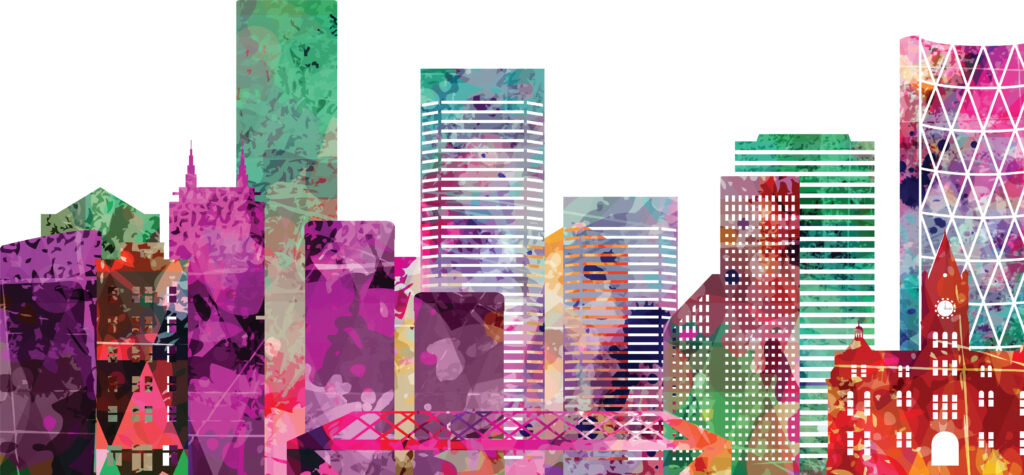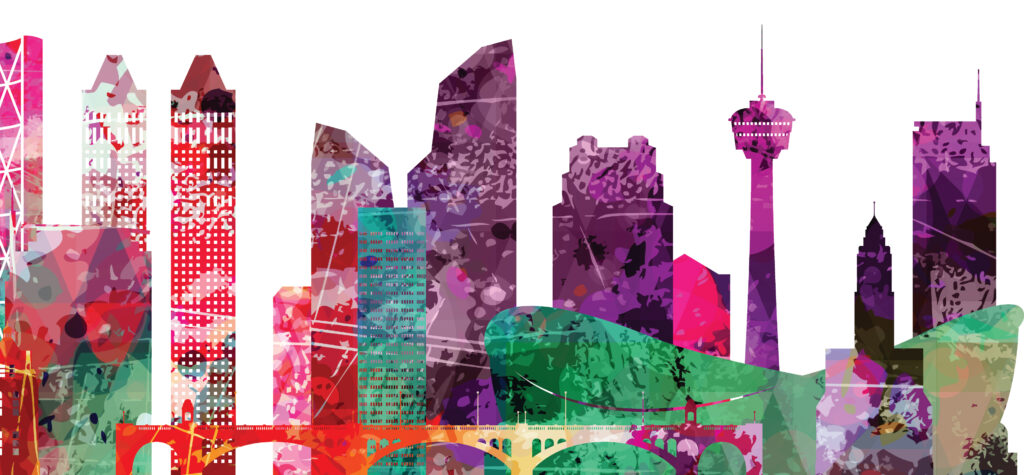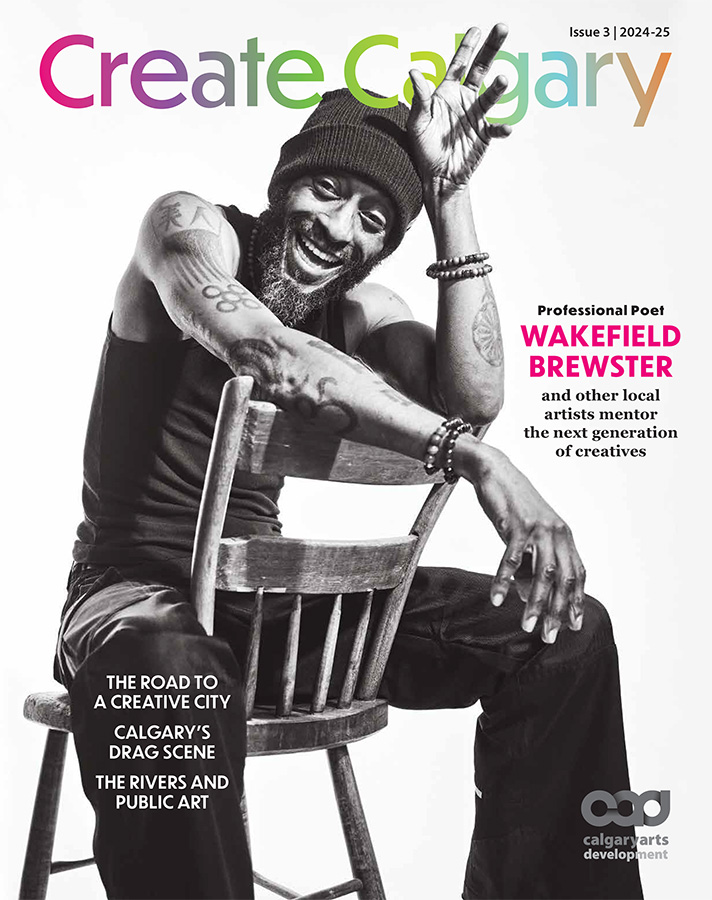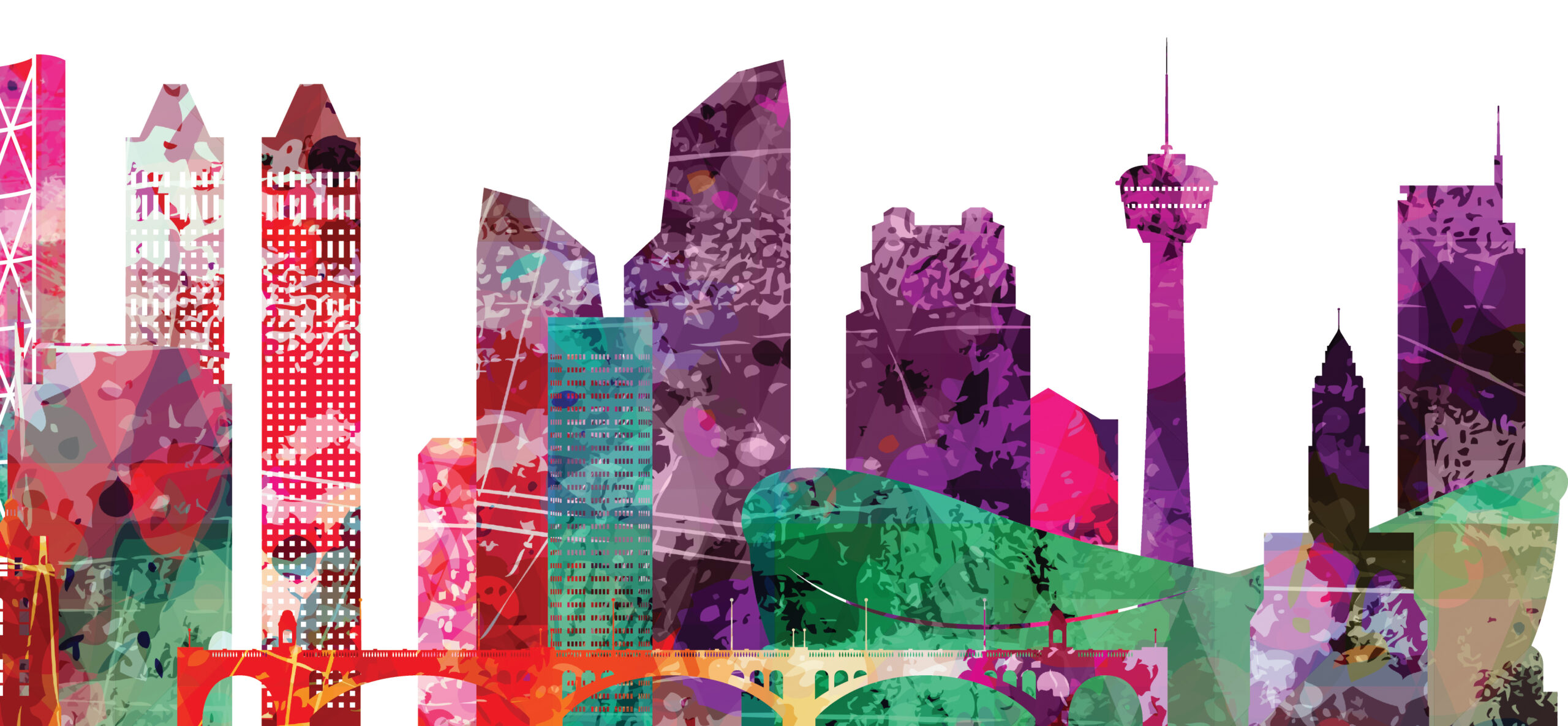The Road to a Creative City
Collaboration is key for Calgary to strategically drive prosperity through the creative economy
Singer-songwriter and Canadian icon Jann Arden began developing her distinct sound by playing original music in the basement of Calgary’s Smuggler’s Inn in the 1980s. Internationally recognized visual artist Chris Cran has called Calgary home since the 1970s, and dancer and pop superstar Tate McRae attended Western Canada High School before recently making her big break in the U.S. Talented artists, bold innovators and creative minds have long been embedded in the fabric of the city.
Although Calgary has always been a place where creativity grows, it’s often overlooked as a creative city globally and even sometimes by Calgarians themselves. Despite the creative talent in Calgary, it’s still often seen as a business centre, known mostly for its oil and gas industry. But there’s a lot more to Calgary, and the city is working to leverage its potential from all sectors, most notably its creative and cultural industries like film, publishing, digital media, interactive technologies, sound recording and the arts.
With support from different civic partners and programs, Calgary Arts Development, Calgary Economic Development (CED) and Mount Royal University created a strategic roadmap called CreativeCITY to help drive a vibrant creative economy. The collaborators looked to community engagement, creative leaders, research and reports to build this strategy, which has developed the building blocks for Calgary to strengthen its creative economy.
The goal is for Calgary’s creative economy to gain recognition as a global leader in order to capitalize on the associated social and economic benefits.

IMAGE: Green87, from iSTOCK; Zenobillis, from iSTOCK; Veronica Cowan
A CREATIVE ECONOMY: TOGETHER IS BETTER
While creativity might be thought of as relevant to the arts sector alone, a creative economy looks through a wider lens and sees it across all industries. Patti Pon, president and CEO of Calgary Arts Development, explains that the direct output of creativity is innovation, and there’s a need for innovation across all industries. Innovation looks to solve problems in new ways, address social issues and make cutting-edge contributions to society. “If all of us practice more creativity, we will be more innovative, and we will be able to contribute in more meaningful ways in a world that’s having a lot of struggles right now,” she says.
A creative economy acknowledges that creativity is found in many industries, and there’s strength in supporting unified growth across them. “We believe we can have an impact if we actually do things together, and that’s what CreativeCITY does; it provides a place to aggregate the work of everyone and to demonstrate the larger impact of the creative economy as a whole, not of its parts,” says Kaley Beisiegel, principal consultant of Bird Creatives, the consultancy that authored the CreativeCITY strategy.
The strategy aims to put Calgary on the global map as a creative city, make it the most liveable city in the country and unconditionally tie creativity to its DNA. This, in turn, will drive the economy and make for a better Calgary.
As Calgary gains recognition as a hub where creatives can successfully live, work and play, it attracts more like-minded people. The more attractive a city, the more things happen here — more events and conferences fill the calendar, more businesses and corporate offices set up shop, more innovators offer more solutions to city issues and more money flows, particularly to tourism, hospitality and entertainment industries as more people come here to work and visit.
“This is not about art being nice to have. This is about business. This is about making money for the benefit of our community at large,” affirms Pon. “When an artist has more money in her pocket, it means there’s more money in the pockets of arts venues, restaurants, the parking authority, arts educators, arts institutions and art post-secondary.”
CED acts as a champion of the CreativeCITY strategy with Calgary Arts Development. CED president and CEO Brad Parry explains what CreativeCITY aims to do for Calgary’s creative sector is what has been done to position the city as business-friendly with other industries. “The more we can tell stories about the artists that are here, the more we get recognition, and the more people want to come. It’s one of those circular economy things that we want to keep building, but we have to tell the stories just like we do with business right now,” he says. “We’re attracting that kind of high-level global talent into the city that just keeps reinforcing the fact that we want to invest in this and see the future for us in this creative economy.”

IMAGE: Green87, from iSTOCK; Zenobillis, from iSTOCK; Veronica Cowan
BUILDING BLOCKS IN PLACE
At the time the 2021 CreativeCITY Ecosystem Report was published, roughly 50,000 Calgarians volunteered in the creative economy, and Calgary had the highest labour force productivity of any major Canadian city. These levels of volunteerism and productivity generate big money. Before the pandemic, in 2019, the creative sector in all of Alberta employed a total of 45,600 individuals and contributed $4.2 billion to GDP. In 2020, even with the effects of the pandemic, the Calgary music sector alone generated $1.7 billion of Alberta’s GDP. The impact of Indigenous creative sectors locally shouldn’t be understated either — the Indigenous economy contributed $1.5 billion to Calgary’s GDP in 2021.
“We have the resources, the talent, the people and, more importantly, we understand the value of having a solid creative economy and creative innovative thinking, and how it’s going to help drive us even more into a world where people see Calgary as a place where they can come and really do some outstanding work around whatever mediums they have,” says Parry.
As the city’s different industries intersect through CreativeCITY, the aim is to gain traction and recognition of Calgary’s creative assets. So, when Calgary plays host to major events like the World Petroleum Congress or the upcoming North American Indigenous Games, Calgary Arts Development understands the importance of using those platforms to showcase the city’s creativity. “When there are a lot of eyeballs on Calgary during these major events, I want their eyeballs to see the strength, vibrancy and vitality of Calgary’s arts and culture ecosystems,” says Pon. “Now is not the time to take our foot off the gas. If anything, it’s time to press harder.”
Many people simply don’t know about the amazing things happening in Calgary, explains Parry. But they are happening. Calgary is home to the Music Mile and Arts Commons — the largest performing arts facility in Western Canada — and MovieMaker Magazine ranked Calgary as the eighth-best city for filmmakers in North America on its 2024 list. “If we’re already seeing this type of success without a coordinated effort, and if we can get our ducks in a row and really make sure that we’re supporting this opportunity in the way that it needs to be, then we’re going to see the benefits as a city,” says Beisiegel. Those benefits centre on increased liveability through more social and economic resources for residents.
A CreativeCITY strategic guidebook is available for anyone in the creative economy to build on what they contribute to the city, whether through a grant, business loan or other tools, but primarily through working with others. Beisiegel explains that companies and organizations often look for their own advancement. But, the sum is greater than its parts, so the guidebook is designed to look at the creative economy at large and the broad opportunities that come with collaboration among various sectors. “It identifies those opportunity areas and provides a framework for how we can pursue this work together,” she says.

IMAGE: Green87, from iSTOCK; Zenobillis, from iSTOCK; Veronica Cowan
A BRIGHT CREATIVE FUTURE
CreativeCITY consists of a four-part plan: making creativity the heart of everything done in the city; unifying the creative economy under one identity; giving the creatives of the city the right tools to succeed; and tapping into the city’s diversity.
The strategy has established the framework and outlined steps to move forward, and now, it’s up to creative individuals and groups to take those pieces and run with them. Calgary creatives must see themselves as members of the creative economy and look at what they’re bringing to it. Then, they need to look at how they can collaborate with others to do more. For instance, if you’re an arts educator or an artist trying to pass on your knowledge to new artists to continue your artform, look at how you can work with organizations embedding more arts into formal education or arts groups developing legacy-building platforms.
Ultimately, it all comes down to building a better Calgary. A future where Calgary is a globally recognized creative city would benefit many. Beisiegel affirms that a strong creative economy improves economic and social challenges. The more liveable a city, the more social issues are addressed, and the more creatives are attracted to plant their roots in Calgary and help drive the economy.
“If we continue to pull together as a city and take on the values and aspirations of what this guidebook is — a collaborative effort to fast forward to mutually beneficial outcomes for everyone in the city — the outlook for Calgary is really great,” says Beisiegel.
For your own copy of the CreativeCITY guidebook, visit here.
This article was originally published in the 2024 edition of Create Calgary, an annual magazine launched by Calgary Arts Development to celebrate the work of artists who call Mohkinsstsis/Calgary home.
You can pick up a free copy at public libraries, community recreation centres and other places where you find your favourite magazines. You can also read the digital version online here.

